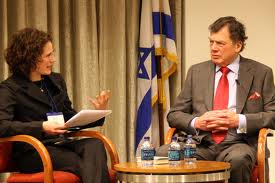Category Archives: Jewish Organizations
Going from the Private Sector to the Non-Profit Sector can be surprising, compensation-wise
This gallery contains 1 photo.
I knew there would be many adjustments needed to switch from the business world...“Like synagogues, the Jewish federation system…once defined community for North American Jews. … Today, however, Federation seems distant from the lives of most Jewish young people….”
This gallery contains 0 photos.
Like synagogues, the Jewish federation system (usually referred to simply as “Federation”) is another...A Pragmatic Reason for Jewish Federations to Reach Out to Intermarried Couples
This gallery contains 0 photos.
Olitzky told me that many in the organized Jewish community are beginning to recognize...“At one time, it was deemed a good thing to have many Jewish organizations…”
At one time, it was deemed a good thing to have many Jewish organizations, as that meant, it was said, that more Jews would be involved in Jewish life. The trouble with that theory is that organizations chew up money and, even when they no longer have much relevance, they never die. The paid professionals see to that.
Edgar M. Bronfman and Beth Zasloff, Hope, Not Fear: A Path to Jewish Renaissance (New York: St. Martin’s Press, 2008), 174.
“If we want real institutional change, all areas of the Jewish community should seek to foster young leadership”
…if we want real institutional change, all areas of the Jewish community should seek to foster young leadership. In every commencement speech, we hear youth described as our future. This is most certainly true, and, yet, Jewish organizations are loath to act on that dictum. The reason is obvious: No one wants to be usurped and declared redundant, so we hang on, in many cases, as long as possible, and keep the young aspirants for Jewish communal life at bay.
Edgar M. Bronfman and Beth Zasloff, Hope, Not Fear: A Path to Jewish Renaissance (New York: St. Martin’s Press, 2008), 177.
“Let’s redirect funds used for fighting anti-Semitism toward Jewish renaissance programs”
…let’s redirect funds used for fighting anti-Semitism toward Jewish renaissance programs. I have publicly stated that it is a waste of the Jewish tax dollar to spend so much money on so-called defense organizations. Anti-Semitism in this country is, for all practical purposes, dead. Yes, there are incidents, but we live in a racist world, and there will always be graffiti and random insults from deranged, sick people. They are a small minority.
Edgar M. Bronfman and Beth Zasloff, Hope, Not Fear: A Path to Jewish Renaissance (New York: St. Martin’s Press, 2008), 175.
“JCCs must now make Jewish education, culture, and identity a central part of their mission”
Jewish Community Centers (JCCs) can also be an important part of the renaissance, as they are positioned to connect with Jews who are not otherwise involved in Jewish life. When the JCC movement began in the mid-nineteenth century with the creation of the Young Men’s Hebrew Association (YMHA), it served as a central resource for Jewish immigrants and a place or celebrations within the new Jewish communities in North America. Today, people go to JCCs for their gyms, art classes, nursery schools, and day camps. JCCs must now make Jewish education, culture, and identity a central part of their mission.
Edgar M. Bronfman and Beth Zasloff, Hope, Not Fear: A Path to Jewish Renaissance (New York: St. Martin’s Press, 2008), 172-173.
“Traditional Jewish institutions must seek guidance from creative young leaders, and some have begun to do so…”
Traditional Jewish institutions must seek guidance from creative young leaders, and some have begun to do so. Young Jews are finding ways to be Jewish outside of traditional Jewish institutions, but that does not mean we have to battle for who controls Jewish life….
We need to cultivate this spirit of openness and exchange between new efforts and traditional Jewish institutions. Both are important for the renaissance. While there is exuberant energy outside the established Jewish community, there are tremendous financial, structural, and human resources in our large institutions. These resources can, and should, be used to educate and empower our youth. While change may happen more quickly in new efforts, existing organizations are capable of making a significant difference in Jewish life if they are willing to adapt to the conditions of the twenty-first century. They need to reach out to young people and invite their ideas and their leadership.
Edgar M. Bronfman and Beth Zasloff, Hope, Not Fear: A Path to Jewish Renaissance (New York: St. Martin’s Press, 2008), 167-168.
Rabbi Elie Kaunfer on institutions in Jewish life
If institutions are performing their mission well, and their mission is still relevant, they will thrive. If either of these is not the case, let’s not put them on life support. American Judaism is in need of revival now, and it behooves us to look to whatever energy is coming forward and encourage it without the constant check on how it will or won’t support an existing institution.
Elie Kaunfer, “The Real Crisis in American Judaism”, The Jewish Week (7 April 2010), 14.

